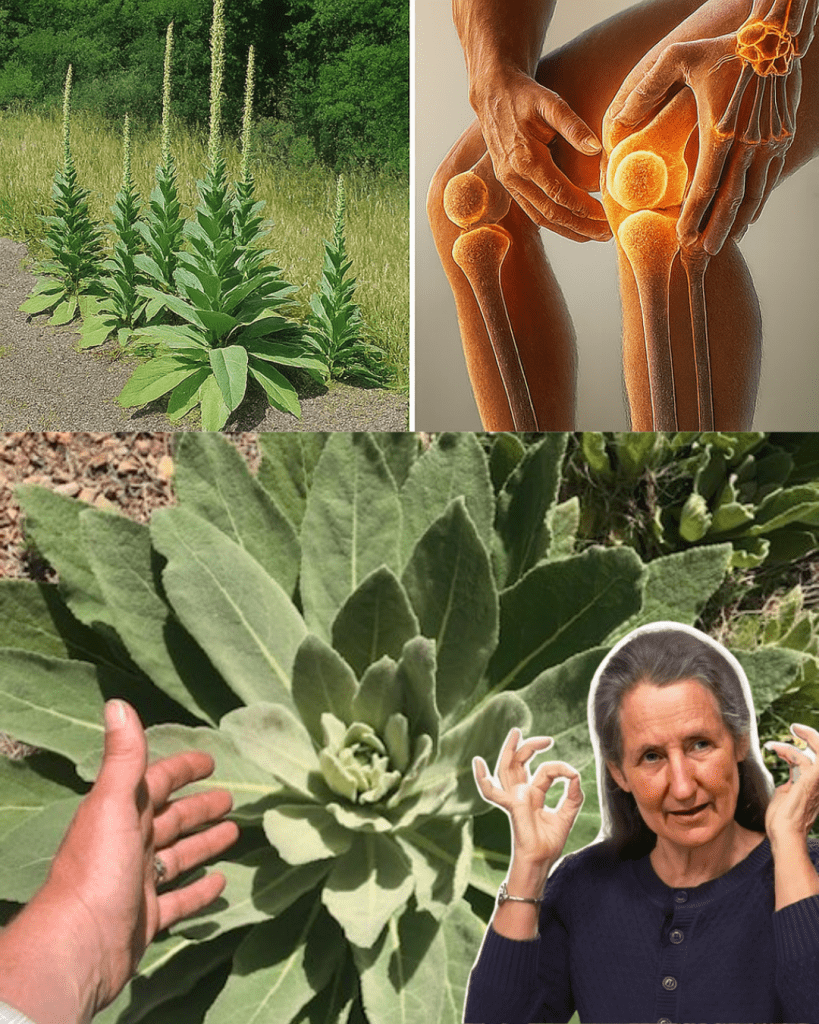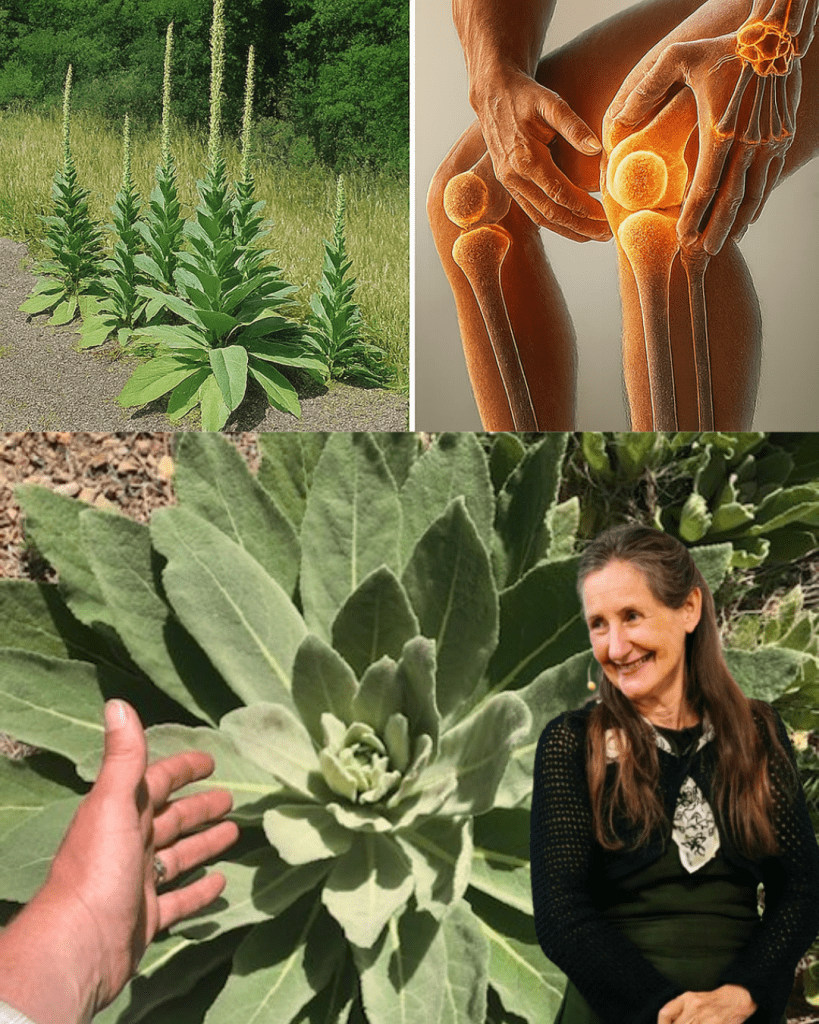Have you ever brushed past a fuzzy-leafed plant on a hike and wondered if it holds secrets beyond its humble appearance? Common mullein (Verbascum thapsus), with its velvety leaves and towering golden flower spikes, is no ordinary weed—it’s a time-honored herb bursting with wellness potential. Celebrated for centuries across Europe, Asia, and North America, mullein is now captivating health-conscious Americans with its ability to soothe lungs, calm skin, and support vibrant health. Ready to unlock the magic of this remarkable plant? Dive into its science-backed benefits, learn safe ways to use it at home, and discover why mullein is your new go-to for natural healing in 2025.

What Is Common Mullein?
Common mullein, often called woolly mullein or Aaron’s rod, is a biennial herb in the Scrophulariaceae family, native to Europe, Asia, and North Africa but now thriving across the U.S. In its first year, it forms a rosette of soft, gray-green leaves; in its second, it shoots up a statuesque stalk adorned with vibrant yellow flowers. Packed with bioactive compounds like flavonoids, saponins, and mucilage, mullein has been a staple in traditional medicine for respiratory relief, skin care, and digestive support. Its accessibility—growing wild in fields or easily cultivated—makes it a favorite for those seeking nature’s finest remedies.
🌱 A Global Healer
From ancient herbalists to modern wellness enthusiasts, mullein’s versatility spans cultures and centuries.
🔬 Bioactive Bounty
Its leaves, flowers, and roots brim with compounds that may ease inflammation, clear mucus, and fight bacteria.
💡 Backyard Wellness
Whether foraged or grown, mullein brings natural healing right to your doorstep.
Let’s explore how this herb can transform your health, starting with its standout benefits.
🌬️ Soothe Your Lungs: Mullein’s Respiratory Magic
When cold season strikes or allergies flare, common mullein shines as a gentle ally for respiratory health. Its compounds work in harmony to clear airways and calm irritation, making it a must-have for wellness routines.
🌿 Clears Congestion
Saponins act as natural expectorants, thinning mucus to help you breathe easier and expel lung congestion.
🔥 Reduces Airway Inflammation
Flavonoids like verbascoside calm inflamed tissues, easing discomfort from coughs or bronchitis.
😷 Soothes Sore Throats
Mucilage coats irritated throats, providing a protective, soothing layer for relief from persistent coughing.
🦠 Fights Viruses
Early research suggests mullein may combat influenza A, offering a natural defense during flu season.
How to Use for Respiratory Support
- Mullein Tea: Steep 1–2 teaspoons of dried mullein leaves or flowers in 8 ounces of boiling water for 10–15 minutes. Strain through a fine mesh or cheesecloth to remove tiny hairs, which can irritate. Drink once daily to ease respiratory discomfort.
- Tip: Add a teaspoon of honey or a slice of lemon for a smoother, tastier sip.
🩹 Heal Your Skin: Mullein’s Soothing Touch
From minor cuts to irritated rashes, mullein’s antimicrobial and anti-inflammatory properties make it a natural choice for skin wellness. Its gentle action nurtures your skin, helping it recover and glow.
🩺 Speeds Wound Healing
Mullein’s compounds promote tissue repair, making it ideal for minor cuts, burns, or post-surgical recovery.
🌸 Calms Irritation
Flavonoids reduce redness and swelling, soothing rashes, burns, or eczema flare-ups.
🦠 Fights Bacteria
Its antimicrobial action helps prevent infections in minor skin wounds, keeping them clean and healthy.
💧 Hydrates and Protects
Mucilage forms a protective coating, locking in moisture and shielding irritated skin from further damage.
How to Use for Skin Care
- Mullein Poultice: Crush fresh, clean mullein leaves into a paste. Apply to minor cuts, burns, or rashes for 10–15 minutes, then rinse thoroughly. Perform a patch test on your inner wrist to check for sensitivity.
- Tip: Use sterile tools and clean leaves to avoid contamination.
🍵 Settle Your Stomach: Mullein’s Digestive Comfort
Beyond lungs and skin, mullein has a long history of easing digestive woes, offering gentle relief for an unsettled stomach or gut inflammation.
🔥 Soothes Gut Inflammation
Verbascoside and other compounds may reduce inflammation in the digestive tract, easing discomfort from conditions like IBS.
🚽 Eases Diarrhea
Traditional remedies use mullein to calm intestinal spasms and normalize bowel movements.
🛡️ Protects the Stomach
Mucilage coats the stomach lining, providing a soothing barrier against irritation or acidity.
🧬 Supports Liver Health
Ursolic acid may shield the liver from toxins, promoting overall digestive wellness.
How to Use for Digestive Support
- Mullein Tea: Boil 1–2 grams of dried leaves in 1 cup of water for 10 minutes. Strain well and sip 1–2 tablespoons daily, ideally after consulting a healthcare provider.
- Tip: Pair with a light meal to enhance digestion.
💪 Boost Overall Wellness: Mullein’s Hidden Perks
Mullein’s benefits extend beyond specific ailments, offering holistic support for a vibrant, healthy life. Its compounds complement a balanced lifestyle, making it a versatile addition to your wellness toolkit.
🛡️ Antioxidant Defense
Flavonoids like quercetin neutralize free radicals, protecting cells and supporting long-term health.
🦠 Antibacterial Power
Mullein may combat harmful bacteria like E. coli and Staphylococcus aureus, bolstering your body’s defenses.
👂 Relieves Earaches
Mullein-infused oil, when used safely, can reduce ear pain, especially in children, with a doctor’s approval.
🦴 Eases Joint Discomfort
Its anti-inflammatory properties may soothe arthritis or muscle soreness, promoting mobility.
How to Use for General Wellness
- Mullein Capsules: Follow package instructions (typically 500–1000 mg daily) for systemic benefits, under medical guidance.
- Mullein Oil: Apply 1–2 drops of mullein-infused oil to the ear for earaches (only if eardrum is intact) or massage onto joints for relief.
- Tip: Always consult a doctor before using oil in ears, especially for children.
🍃 How to Use Mullein Safely
Incorporating common mullein into your routine is simple, but precision ensures safety and effectiveness. Here are the best methods, tailored for ease and impact.
🌿 Mullein Tea for Internal Use
- Add 1–2 teaspoons of dried leaves or flowers to 8 ounces of boiling water.
- Steep for 10–15 minutes, then strain through a fine mesh or cheesecloth to remove irritating hairs.
- Drink up to three times daily for respiratory or digestive support.
- Tip: Store leftover tea in the fridge for up to 24 hours and reheat gently.
🩹 Topical Poultice for Skin
- Crush fresh, thoroughly washed leaves into a paste using a clean mortar and pestle.
- Apply to minor skin irritations for 10–15 minutes, then rinse with warm water.
- Test on a small skin patch first to rule out allergies.
🛢️ Mullein-Infused Oil
- Use commercially prepared mullein oil or make your own by infusing dried flowers in olive oil for 2 weeks.
- Apply 1–2 drops in the ear for earaches (with medical approval) or massage onto joints for discomfort.
- Tip: Store oil in a dark, cool place for up to 6 months.
Safety Tips for Success
🔍 Start Small: Begin with a low dose (e.g., 1 teaspoon tea or 1 drop oil) to assess tolerance.
🌿 Choose Quality: Opt for organic mullein from reputable suppliers to avoid pesticides or contaminants.
🩺 Consult a Doctor: Seek medical advice, especially if you have chronic conditions or take medications.
🚫 Avoid Hairs: Always strain tea thoroughly to remove fine hairs, which can irritate the throat or skin.
🔬 What Science Says About Mullein
Research on common mullein is growing, but most studies are preclinical, focusing on animal models or lab tests. Key findings include:
- A 2005 study confirmed its expectorant and bronchodilatory effects, supporting its use for respiratory relief.
- A 2021 study demonstrated mullein’s role in wound healing, particularly for surgical recovery.
- Antibacterial and antiviral properties were noted against E. coli, Staphylococcus aureus, and influenza A in studies from 2002 and 2023.
- Anti-inflammatory effects were linked to flavonoids in a 2021 study, aiding conditions like arthritis or airway irritation.
However, human clinical trials are sparse, and herbal supplements lack FDA regulation for safety or efficacy. This makes professional guidance essential, especially for long-term use or specific health goals.
🌾 Harvesting and Sourcing Mullein Like a Pro
To ensure you’re getting the best from common mullein, follow these tips for harvesting, sourcing, or growing your own supply.
🌿 Harvesting Tips
- Collect leaves and flowers from clean, pesticide-free areas, far from roads or polluted zones.
- Harvest leaves in the first year for maximum potency; pick flowers in the second year during summer bloom.
- Dry leaves and flowers in a shaded, well-ventilated area to preserve their compounds.
🛒 Sourcing Wisely
- Buy from trusted suppliers with third-party testing (e.g., NSF or USP) to ensure purity and avoid contaminants.
- Look for organic, non-GMO mullein to minimize exposure to pesticides.
- Check for clear labeling on teas, capsules, or oils, including dosage instructions.
🏡 Growing Your Own
- Plant mullein in well-drained, sunny soil; it thrives in low-maintenance gardens.
- Sow seeds in spring for a biennial cycle, harvesting leaves and flowers as needed.
- Tip: Mullein self-seeds easily, so manage growth to prevent it from overtaking your garden.
Storage Know-How
- Store dried mullein in airtight containers in a cool, dry place for up to 12 months.
- Keep oils in dark glass bottles to maintain potency for 6–12 months.
⚠️ Proceed with Caution
Common mullein is safe for most when used properly, but these precautions ensure a worry-free experience:
🚫 Allergy Risks: Some may experience skin irritation or allergic reactions, especially with topical use. Always do a patch test.
🩺 Medication Interactions: Mullein may interact with diuretics, antidiabetic drugs, or muscle relaxants. Consult your doctor if on medications.
🤰 Pregnancy and Breastfeeding: Avoid use due to limited safety data.
🌱 Seed Toxicity: Mullein seeds contain rotenone, which can be toxic. Use only leaves, flowers, or roots.
🔬 Quality Control: Poor-quality herbs may contain contaminants. Choose tested, reputable brands.
When to Stop Use
Discontinue if you notice rash, nausea, or dizziness, and seek medical advice if symptoms persist.

🌍 Why Mullein is a Wellness Must-Have
Common mullein is riding a wave of popularity, and it’s easy to see why. Its rich history in traditional medicine, combined with emerging science, makes it a compelling choice for natural health enthusiasts. Here’s what fuels its rise:
🌿 Timeless Tradition
From Native American remedies to European herbalism, mullein’s legacy spans cultures and centuries.
💊 Versatile Benefits
Its ability to support lungs, skin, digestion, and more makes it a one-stop herb for holistic wellness.
🏞️ Accessible and Affordable
Found in fields or grown at home, mullein is a budget-friendly remedy for all.
📸 Social Media Star
Its striking flower spikes and fuzzy leaves make it a shareable, photogenic addition to wellness routines.
As health trends lean toward natural, sustainable solutions, mullein stands out as a gentle, effective option for 2025.
✨ Embrace Mullein’s Healing Embrace
Common mullein is more than a roadside weed—it’s a powerhouse of natural healing, offering relief for lungs, skin, digestion, and beyond. With its anti-inflammatory, expectorant, and antimicrobial properties, this herb empowers you to nurture your body the way nature intended. Whether you’re sipping a soothing tea, applying a healing poultice, or exploring its oil for earaches, mullein brings wellness within reach. Pair it with a vibrant lifestyle, and watch your health flourish.
Ready to let mullein work its magic? Brew a cup of mullein tea or craft a poultice today, and feel the difference. Have a favorite mullein remedy or tip to share? Drop it in the comments below and inspire our community. Let’s grow healthier, naturally, together!
This content is for informational purposes only and is not a substitute for professional medical advice. Always consult a healthcare provider before making health changes, especially if you have medical conditions or take medications.









